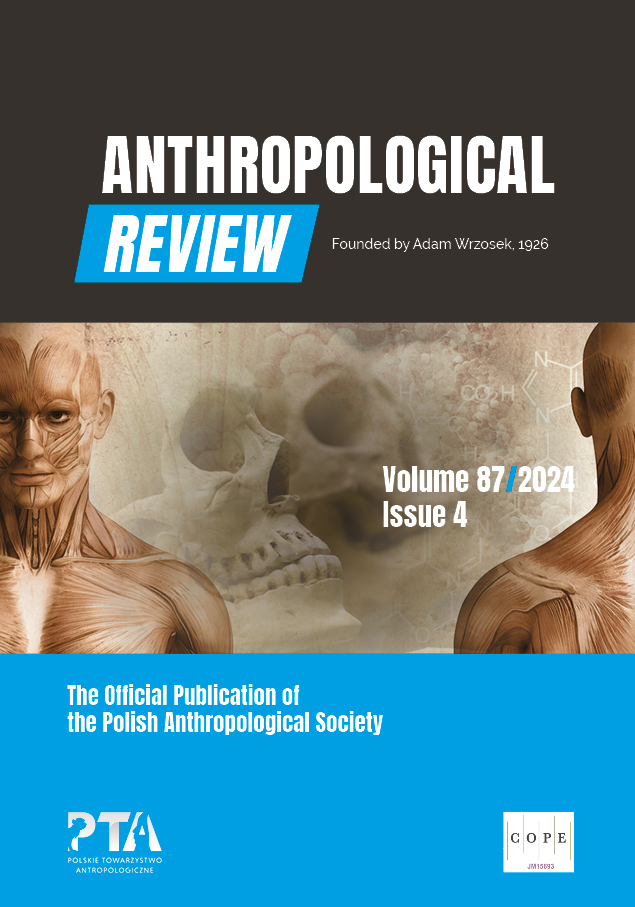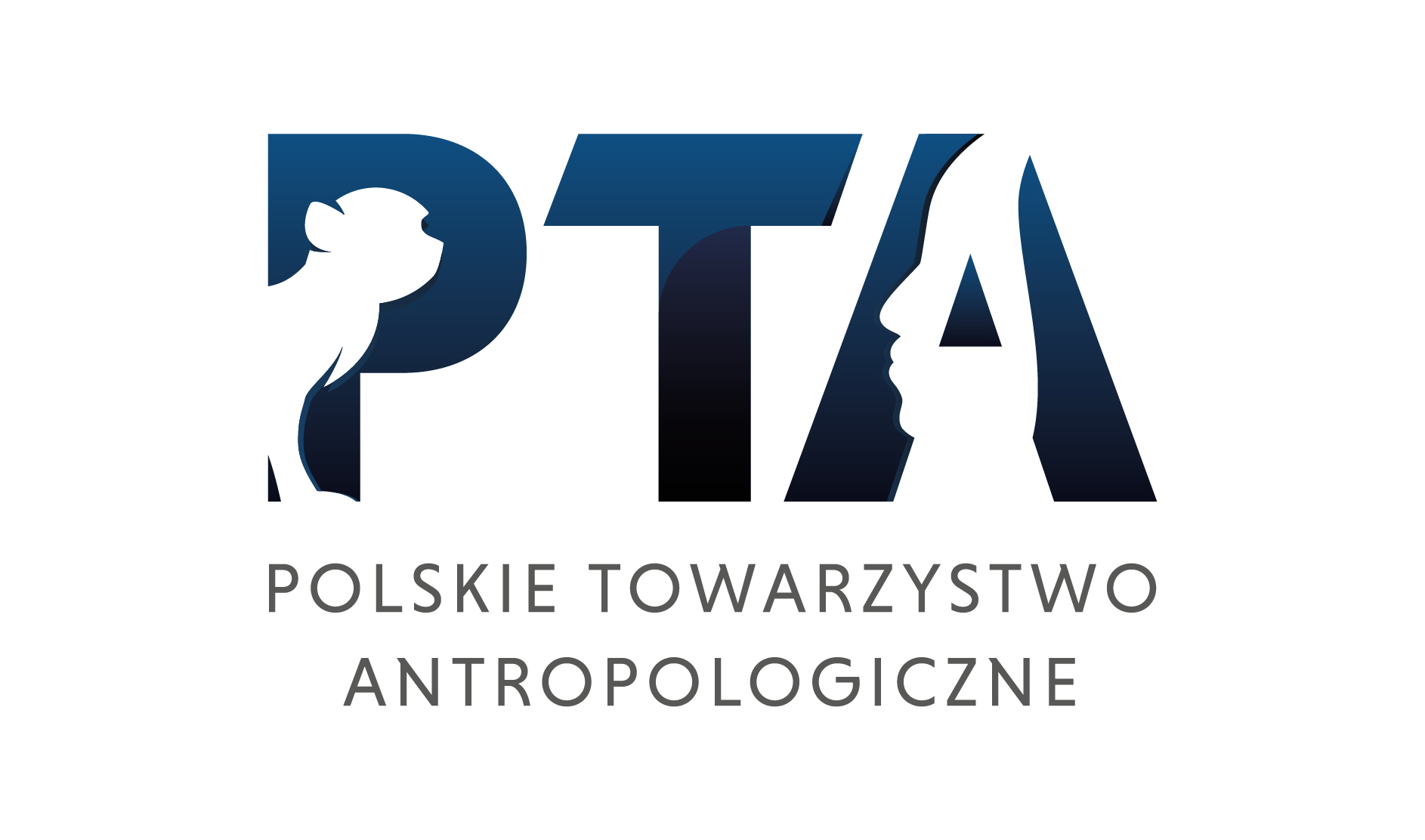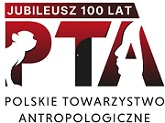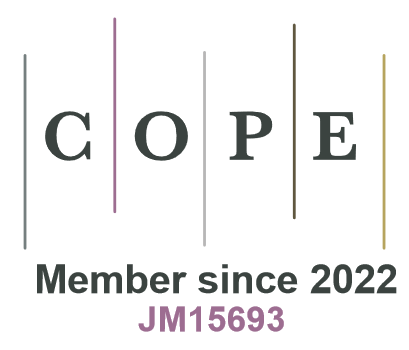Variability of anti-Müllerian hormone and folliculotropic hormone levels in women of reproductive age in relation to normal or impaired ovarian function
DOI:
https://doi.org/10.18778/1898-6773.87.4.07Keywords:
AMH, FSH, reproduction, fertility, POIAbstract
The demographic crisis in Europe is growing due to an increasing proportion of couples with fertility disorders. The purpose of this study was to examine the variability of ovarian reserve markers with age in women with premature ovarian insufficiency (POI) and polycystic ovary syndrome (PCOS) in relative to women with normal ovarian function. Two hormones were analyzed: anti-Müllerian hormone (AMH) and folliculotropic hormone (FSH). This study demonstrates that AMH is a valuable indicator of alterations in reproductive capacity. FSH is a standard marker of the hypothalamic-pituitary-ovarian axis.
We examined the reproductive status of 390 women aged 23–46 years in three groups. Ovarian dysfunction was determined by a medical diagnosis. The study includes women with PCOS (n=154), POI (n=40), and control group (n=196) with normal ovarian function (NOF). Blood samples were collected to measure AMH and FSH. We used multivariate logistic regression analysis to demonstrate the relationship between hormone levels and age in different age groups. ANOVA was used to analyze factors related to AMH and FSH concentrations. The results confirmed that women with POI had significantly lower AMH concentrations and higher FSH concentrations than women with normal ovarian function only in the group of women aged 36–46 years. There were no statistically significant differences in FSH levels in women with POI and NOF in the 23–30 and 31–35 age groups. AMH levels were higher in the PCOS group than in women with NOF in all age groups. FSH marker did not differ compared to the control group in women aged 23–30 and 36–46. The predictive value of AMH in the diagnosis of PCOS is significantly higher than the commonly used FSH. The results may contribute to earlier assessment of biological status to support reproductive chances in women with POI and PCOS.
Downloads
References
Bragg JM, Kuzawa CW, Agustin SS, Banerjee MN, McDade TW. 2012. Age at menarche and parity are independently associated with anti-Müllerian hormone, a marker of ovarian reserve in Filipino young adult women. Am J Hum Biol 24:739–745. https://doi.org/10.1002/ajhb.22309
View in Google Scholar
DOI: https://doi.org/10.1002/ajhb.22309
Carlsen S, Vanky E, Fleming R. 2009. Anti-Müllerian hormone concentrations in androgen-suppressed women with polycystic ovary syndrome. Hum Reprod 24(7):1732–1738. https://doi.org/10.1093/humrep/dep074
View in Google Scholar
DOI: https://doi.org/10.1093/humrep/dep074
Cassar S, Teede HJ, Moran LJ, Joham AE, Harrison CL, Strauss BJ, Stepto NK. 2014. Polycystic ovary syndrome and anti-Müllerian hormone: role of insulin resistance, androgens, obesity and gonadotrophins. J Clin Endocrinol Metabol 81(6):899–906. https://doi.org/10.1111/cen.12557
View in Google Scholar
DOI: https://doi.org/10.1111/cen.12557
Cohen-Haguenauer O, Picard JY, Mattéi MG, Serero S, Van Cong N, de Tand MF, et al. 1987. Mapping of the gene for anti-Müllerian hormone to the short arm of human chromosome 19. Cytogenet Cell Genet 44:2–6. https://doi.org/10.1159/000132332
View in Google Scholar
DOI: https://doi.org/10.1159/000132332
Dewailly D, Robin G, Peigne M, Decanter C, Pigny P, Catteau-Jonard S. 2016. Interactions between androgens, FSH, anti-Müllerian hormone and estradiol during folliculogenesis in the human normal and polycystic ovary. Hum Reprod Update 22(6):709–724. https://doi.org/10.1093/humupd/dmw027
View in Google Scholar
DOI: https://doi.org/10.1093/humupd/dmw027
Di Clemente N, Jamin SP, Lugovskoy A, Carmillo P, Ehrenfels C, Picard JY, et al. 2010. Processing of anti-Müllerian hormone regulates receptor activation by a mechanism distinct from TGF-β. Mol Endocrinol 24(11):2193–206. https://doi.org/10.1210/me.2010-0273
View in Google Scholar
DOI: https://doi.org/10.1210/me.2010-0273
Eldar-Geva T, Margalioth EJ, Gal M, Ben-Chetrit A, Algur N, Zylber-Haran E, Spitz IM. 2005. Serum anti-Müllerian hormone levels during controlled ovarian hyperstimulation in women with polycystic ovaries with and without hyperandrogenism. Hum Reprod 20(7):1814–1819. https://doi.org/10.1093/humrep/deh873
View in Google Scholar
DOI: https://doi.org/10.1093/humrep/deh873
Gardner DG, Shoback D, Lewiński A. 2011. Endokrynología ogólna i kliniczna Greenspana, Tom.II. Wyd.2, Lublin: Wyd. Czelej.
View in Google Scholar
Grossman MP, Nakajima ST, Fallat ME, Siow Y. 2008. Müllerian-inhibiting substance inhibits cytochrome P450 aromatase activity in human granulosa lutein cell Culture. Fertility and Sterility 89(5):1364–1370.
View in Google Scholar
DOI: https://doi.org/10.1016/j.fertnstert.2007.03.066
Guedikian AA, Lee AY, Grogan TR, Abbott DH, Largaespada K, Chazenbalk GD, Dumesic DA. 2018. Reproductive and metabolic determinants of granulosa cell dysfunction in normal-weight women with polycystic ovary syndrome. Fertility and Sterility 109(3):508–515. https://doi.org/10.1016/j.fertnstert.2017.11.017
View in Google Scholar
DOI: https://doi.org/10.1016/j.fertnstert.2017.11.017
Hagen CP, Vestergaard S, Juul A. 2012. Low concentration of circulating anti Müllerian hormone is not predictive of reduced fecundability in young healthy women: a prospective cohort study. Fertility and Sterility. 98:1602–1608. https://doi.org/10.1016/j.fertnstert.2012.08.008
View in Google Scholar
DOI: https://doi.org/10.1016/j.fertnstert.2012.08.008
Hambridge HL, Mumford SL, Mattison DR, Ye A, Pollack AZ, Bloom MS, Schisterman EF. 2013. The influence of sporadic anovulation on hormone levels in ovulatory cycles. Hum Reprod 28(6):1687–1694. https://doi.org/10.1093/humrep/det090
View in Google Scholar
DOI: https://doi.org/10.1093/humrep/det090
Homburg R, Ray A, Bhide P, Gudi A, Shah A, Timms P, Grayson K. 2013. The relationship of serum anti-Müllerian hormone with polycystic ovarian morphology and polycystic ovary syndrome: a prospective cohort study. Hum Reprod 28(4):1077–1083. https://doi.org/10.1093/humrep/det015
View in Google Scholar
DOI: https://doi.org/10.1093/humrep/det015
Kaczmarek M. 2007. The timing of natural menopause in Poland and associated factors. Maturitas 57(2):139–153. https://doi.org/10.1016/j.maturitas.2006.12.001
View in Google Scholar
DOI: https://doi.org/10.1016/j.maturitas.2006.12.001
Kaczmarek M. 2007. Zróżnicowanie wieku menopauzy naturalnej wśród polskich kobiet ze względu na historie okresu rozrodczego. Przegląd Menopauzalny 2:69–76.
View in Google Scholar
Kaczmarek M, Wolański N. 2018. Rozwój biologiczny człowieka od poczęcia do śmierci. Warszawa: 2018.
View in Google Scholar
Kelsey TW, Wright P, Nelson SM, Anderson RA, Wallace WH. 2011. A validated model of serum anti-Müllerian hormone from conception to menopause, PloS one 6(7):e22024. https://doi.org/10.1371/journal.pone.0022024
View in Google Scholar
DOI: https://doi.org/10.1371/journal.pone.0022024
Kerkhof GF, Leunissen RW, Willemsen RH, de Jong FH, Visser JA, Laven JS, Hokken-Koelega AC. 2010. Influence of preterm birth and small birth size on serum anti-Mullerian hormone levels in young adult women. Eur J Endocrinol 163:937–944. https://doi.org/10.1530/eje-10-0528
View in Google Scholar
DOI: https://doi.org/10.1530/EJE-10-0528
Knight P, Glister C. 2006. TGF-β superfamily members and ovarian follicle development. Hum Reprod 132(2):191–206. https://doi.org/10.1530/rep.1.01074
View in Google Scholar
DOI: https://doi.org/10.1530/rep.1.01074
Kuiri-Hänninen T, Kallio S, Seuri R, Tyrväinen E, Liakka A, Tapanainen J, Dunkel L. 2011. Postnatal developmental changes in the pituitary-ovarian axis in preterm and term infant girls. J Clin Endocrinol Metabol 96(11):3432–3439. https://doi.org/10.1210/jc.2011-1502
View in Google Scholar
DOI: https://doi.org/10.1210/jc.2011-1502
Kumar A, Kalra B, Patel A, McDavid L, Roudebush WE. 2010. Development of a second generation anti-Müllerian hormone (AMH) ELISA. J Immunol Methods 362(1–2):51–59. https://doi.org/10.1016/j.jim.2010.08.011
View in Google Scholar
DOI: https://doi.org/10.1016/j.jim.2010.08.011
La Marca A, Broekmans FJ, Volpe A, Fauser BC, Macklon NS. 2009. Anti-Müllerian hormone (AMH): what do we still need to know? Hum Reprod 24(9):2264–2275. https://doi.org/10.1093/humrep/dep210
View in Google Scholar
DOI: https://doi.org/10.1093/humrep/dep210
Lambalk CB, van Disseldorp J, De Koning CH, Broekmans FJ. 2009. Testing ovarian reserve to predict age at menopause. Maturitas 63(4):280–291. https://doi.org/10.1016/j.maturitas.2009.06.007
View in Google Scholar
DOI: https://doi.org/10.1016/j.maturitas.2009.06.007
Lambert-Messerlian G, Plante B, Eklund EE, Raker C, Moore RG. 2016. Levels of antimüllerian hormone in serum during the normal menstrual cycle. Fertility and Sterility 105(1):208–213. https://doi.org/10.1016/j.fertnstert.2015.09.033
View in Google Scholar
DOI: https://doi.org/10.1016/j.fertnstert.2015.09.033
Lee JY, Jee BC, Lee JR, Kim CH, Park T, Yeon BR, et al. 2012. Age related distributions of anti-Müllerian hormone level and anti-Müllerian hormone models. Acta Obstetricia et Gynecologica Scandinavica 91:970–975. https://doi.org/10.1111/j.1600-0412.2012.01448.x
View in Google Scholar
DOI: https://doi.org/10.1111/j.1600-0412.2012.01448.x
Lie Fong S, Visser JA, Welt CK, de Rijke YB, Eijkemans MJ, Broekmans FJ, Themmen AP. 2012. Serum anti-müllerian hormone levels in healthy females: a nomogram ranging from infancy to adulthood. J Clin Endocrinol Metabol 97(12):4650–4655. https://doi.org/10.1210/jc.2012-1440
View in Google Scholar
DOI: https://doi.org/10.1210/jc.2012-1440
Liu S, Hong L, Mo M, Xiao S, Wang X, Fan X, et al. 2022. Association of antimüllerian hormone with polycystic ovarian syndrome phenotypes and pregnancy outcomes of in vitro fertilization cycles with fresh embryo transfer. BMC Pregnancy Childbirth 22(1):171. https://doi.org/10.1186/s12884-022-04518-0
View in Google Scholar
DOI: https://doi.org/10.1186/s12884-022-04518-0
Macklon NS, Fauser BC. 2011. Follicle-stimulating hormone and advanced follicle development in the human. Arch Med Res 32:595–600. https://doi.org/10.1016/s0188-4409(01)00327-7
View in Google Scholar
DOI: https://doi.org/10.1016/S0188-4409(01)00327-7
McGee EA, Hsueh AJ. 2000. Initial and cyclic recruitment of ovarian follicles. Endocrine Rev 21(2):200–214. https://doi.org/10.1210/edrv.21.2.0394
View in Google Scholar
DOI: https://doi.org/10.1210/edrv.21.2.0394
Meczekalski B, Czyzyk A, Kunicki M, Podfigurna-Stopa A, Plociennik L, Jakiel G, et al. 2016. Fertility in women of late reproductive age: the role of serum anti-Müllerian hormone (AMH) levels in its assessment. J Endocrinol Invest 39(11):1259–1265. https://doi.org/10.1007/s40618-016-0497-6
View in Google Scholar
DOI: https://doi.org/10.1007/s40618-016-0497-6
Nelson SM, Yates RW, Fleming R. 2007. Serum anti-Müllerian hormone and FSH: prediction of live birth and extremes of response in stimulated cycles—implications for individualization of therapy. Hum Reprod 22(9):2414–2421. https://doi.org/10.1093/humrep/dem204
View in Google Scholar
DOI: https://doi.org/10.1093/humrep/dem204
Pankhurst MW, Clark CA, Zarek J, Laskin CA, McLennan IS. 2016. Changes in circulating proAMH and total AMH during healthy pregnancy and post-partum: a longitudinal study. PloSone 11(9):0162509. https://doi.org/10.1371/journal.pone.0162509
View in Google Scholar
DOI: https://doi.org/10.1371/journal.pone.0162509
Pankhurst MW, Leathart BL, Batchelor NJ, McLennan IS. 2016. The anti-Müllerian hormone precursor (proAMH) is not converted to the receptor-competent form (AMHN, C) in the circulating blood of mice. Endocrinology. 157(4):1622–1629. https://doi.org/10.1210/en.2015-1834
View in Google Scholar
DOI: https://doi.org/10.1210/en.2015-1834
Pankhurst MW. 2017. A putative role for anti-Müllerian hormone (AMH) in optimising ovarian reserve expenditure. J Endocrinol 233(1):R1–13. https://doi.org/10.1530/joe-16-0522
View in Google Scholar
DOI: https://doi.org/10.1530/JOE-16-0522
Pankhurst MW, Shorakae S, Rodgers RJ, Teede HJ, Moran LJ. 2017. Efficacy of predictive models for polycystic ovary syndrome using serum levels of two anti Müllerian hormone isoforms (proAMH and AMHN, C). Fertility and Sterility 108(5):851–857. https://doi.org/10.1016/j.fertnstert.2017.08.012
View in Google Scholar
DOI: https://doi.org/10.1016/j.fertnstert.2017.08.012
Pawelczyk L, Sokalska A, Serdyńska M. 2003. Płodność u kobiet w wieku przedmenopauzalnym. Przegląd Menopauzalny 1:14–18.
View in Google Scholar
Pigny P, Merlen E, Robert Y, Cortet-Rudelli C, Decanter C, Jonard S, Dewailly D. 2003. Elevated serum level of anti-Müllerian hormone in patients with polycystic ovary syndrome: relationship to the ovarian follicle excess and to the follicular arrest. J Clin Endocrinol Metabol 88(12):5957–5962. https://doi.org/10.1210/jc.2003-030727
View in Google Scholar
DOI: https://doi.org/10.1210/jc.2003-030727
Piltonen T, Morin-Papunen L, Koivunen R, Perheentupa A, Ruokonen A, Tapanainen JS. 2005. Serum anti-Müllerian hormone levels remain high until late reproductive age and decrease during metformin therapy in women with polycystic ovary syndrome. Hum Reprod 20(7):1820–1826. https://doi.org/10.1093/humrep/deh850
View in Google Scholar
DOI: https://doi.org/10.1093/humrep/deh850
Randolph Jr, JF, Harlow SD, Helmuth ME, Zheng H, McConnell DS. 2014. Updated assays for inhibin B and AMH provide evidence for regular episodic secretion of inhibin B but not AMH in the follicular phase of the normal menstrual cycle. Hum Reprod 29(3):592–600. https://doi.org/10.1093/humrep/det447
View in Google Scholar
DOI: https://doi.org/10.1093/humrep/det447
Ray A, Shah A, Homburg R. 2012. Is there a role of antimullerian hormone in diagnosis of PCOS? a prospective cohort study. Fertility and Sterility 98(3):S53.1
View in Google Scholar
DOI: https://doi.org/10.1016/j.fertnstert.2012.07.189
Skałba P, Cygal A, Dąbkowska-Huć A. 2008. Wpływ hormonu anty-Müllerowskiego (AMH) na folikulogenezę. Ginekologia Polska 79:137–140.
View in Google Scholar
Sova H, Unkila-Kallio L, Tiitinen A, Hippeläinen M, Perheentupa A, Tinkanen H. 2019. Hormone profiling, including anti-Müllerian hormone (AMH), for the diagnosis of polycystic ovary syndrome (PCOS) and characterization of PCOS phenotypes. Gynecol Endocrinol 35(7):595–600. https://doi.org/10.1080/09513590.2018.1559807
View in Google Scholar
DOI: https://doi.org/10.1080/09513590.2018.1559807
Sowers M, McConnell D, Gast K, Zheng H, Nan B, McCarthy JD, Randolph JF. 2010. Anti-Müllerian hormone and inhibin B variability during normal menstrual cycles. Fertility and Sterility 94(4):1482–1486.
View in Google Scholar
DOI: https://doi.org/10.1016/j.fertnstert.2009.07.1674
Stanisz A. 2007. Przystępny kurs statystyki z zastosowaniem STATISTICA PL na przykładach z medycyny. Kraków: StatSoft Polska.
View in Google Scholar
Streuli I, Fraisse T, Chapron C, Bijaoui G, Bischof P, De Ziegler D. 2009. Clinical uses of anti-Müllerian hormone assays: pitfalls and promises. Fertility and Sterility 91(1):226–230. https://doi.org/10.1016/j.fertnstert.2007.10.067
View in Google Scholar
DOI: https://doi.org/10.1016/j.fertnstert.2007.10.067
Tal R, Seifer DB, Khanimov M, Malter HE, Grazi RV, Leader B. 2014. Characterization of women with elevated antimullerian hormone levels (AMH): correlation of AMH with polycystic ovarian syndrome phenotypes and assisted reproductive technology outcomes. Am J Obstet Gynecol 211(1):59.e1–8. https://doi.org/10.1016/j.ajog.2014.02.026
View in Google Scholar
DOI: https://doi.org/10.1016/j.ajog.2014.02.026
Urrutia M, Grinspon RP, Rey RA. 2019. Comparing the role of anti-Müllerian hormone as a marker of FSH action in male and female fertility. Expert Rev Endocrinol Metab 14(3):203–214. https://doi.org/10.1080/17446651.2019.1590197
View in Google Scholar
DOI: https://doi.org/10.1080/17446651.2019.1590197
Vale-Fernandes E, Barreiro M, Leal C, Macedo RZ, Tomé A, Monteiro MP. 2023. Elevated Anti-Müllerian Hormone as a Prognostic Factor for Poor Outcomes of In Vitro Fertilization in Women with Polycystic Ovary Syndrome. Biomedicines 11(12):3150. https://doi.org/10.3390/biomedicines11123150
View in Google Scholar
DOI: https://doi.org/10.3390/biomedicines11123150
Visser JA, de Jong FH, Laven JS, Themmen AP. 2006. Anti-Müllerian hormone: a new marker for ovarian function. Reproduction 131(1):1–9. https://doi.org/10.1530/rep.1.00529
View in Google Scholar
DOI: https://doi.org/10.1530/rep.1.00529
Visser JA, Themmen AP. 2014. Role of anti-Müllerian hormone and bone morphogenetic proteins in the regulation of FSH sensitivity. Mol Cell Endocrinol 382(1):460–465. https://doi.org/10.1016/j.mce.2013.08.012
View in Google Scholar
DOI: https://doi.org/10.1016/j.mce.2013.08.012
Published
Versions
- 23-01-2025 (2)
- 23-01-2025 (1)
How to Cite
Issue
Section
License

This work is licensed under a Creative Commons Attribution-NonCommercial-NoDerivatives 4.0 International License.









